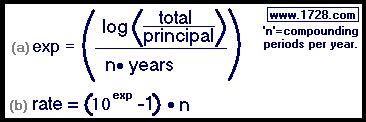|
Four Compound Interest Formulas
For semi-annual, quarterly, monthly, and daily compounding.
Formulas solved for total, principal, years and rate
* * * * * * * * * * * * * * * * * * * * * * * * * * * * * * * * * * * *

You have $1,200 in a savings account with an interest rate of 7 per cent compounded semi-annually.
How much money do you have after 5 years?
Total = 1,200 * (1+.[07 ÷ 2])2•5
Total = 1,200 * (1.035)10
Total = 1,200 * 1.4105987606
Total = 1,692.72
|
|
* * * * * * * * * * * * * * * * * * * * * * * * * * * * * * * * * * * *

After 10 years in a 6% compounded quarterly savings account, you have $18,140.19.
What amount was invested originally?
Principal = $18,140.19 ÷ (1 + [.06÷2])4•10
Principal = $18,140.19 ÷ 1.01540
Principal = $18,140.19 ÷ 1.8140184087
Principal = $10,000.00
|
|
* * * * * * * * * * * * * * * * * * * * * * * * * * * * * * * * * * * *

$10,000 invested in a 10% compounded monthly account eventually yields $15,000.
How many years did this take?
Years = log(15,000 ÷ 10,000) ÷ 12*log(1 + (.1/12))
Years = log(1.5) ÷ 12*log(1.00833333333333)
Years = 0.176091259055681 ÷ 12*0.003604124268825
Years = 4.07152209342589
* * * * * * * * * * * * * * * * * * * * * * * * * * * * * * * * * * * *
|
|
Revised August, 2014

After 12 years an initial deposit of $15,000 yields $50,000 in a compounded daily account.
What was the daily rate of this investment?
Using equation (a) ('exp' means exponent)
exp = {log(total ÷ principal)} ÷ n • years
exp = {log(50,000 ÷ 15,000)} ÷ 365 • 12
exp = {log(3.33333333333)} ÷ 4,380
exp = {0.52287874528} ÷ 4,380
exp = 0.000119378708968114
Inserting the exponent into equation (b):
rate = (10exponent -1) • n
rate = (100.000119378708968114 -1) • 365
rate = (1.00027491741856 -1) • 365
rate = (.00027491741856) • 365
rate = 0.10034485777428
Multiplying this by 100 to get a percentage:
rate = 10.034485777428%
Return To Compound Interest Calculator
Return To Home Page
Copyright © 1999 -
1728 Software Systems
|



